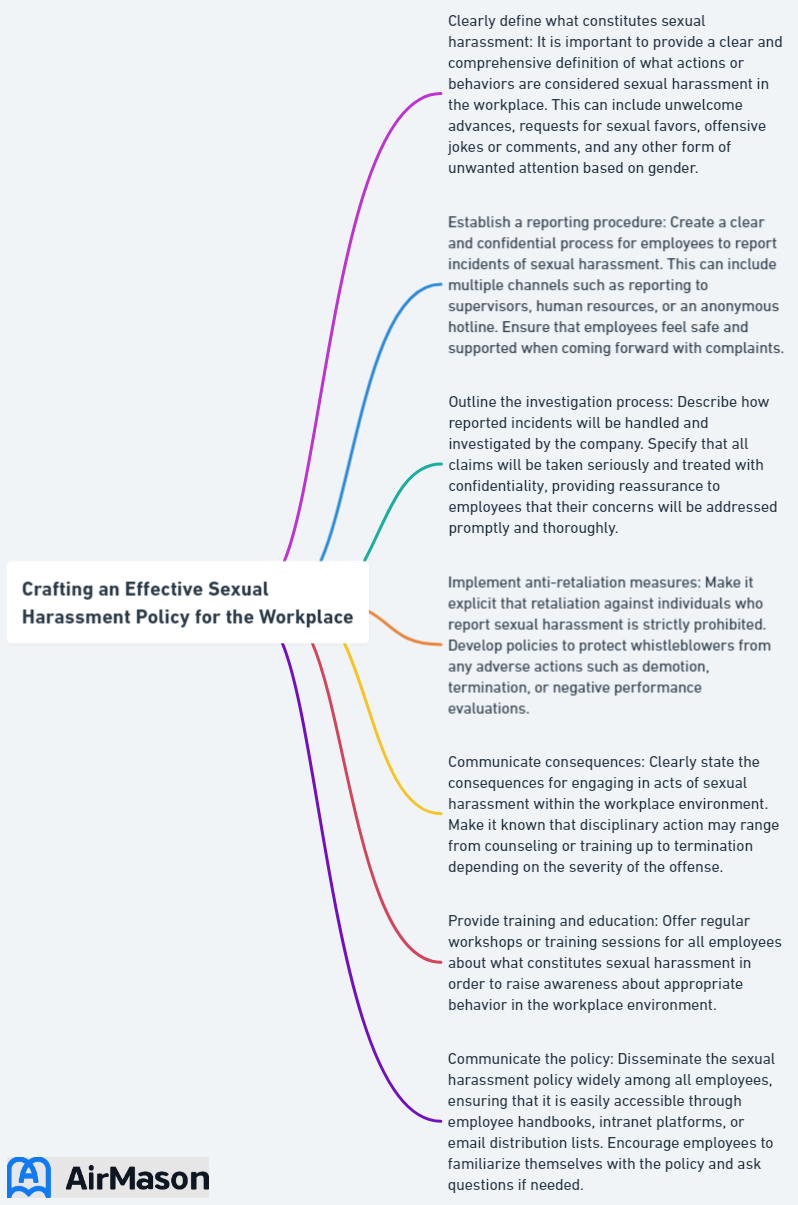
Workplace sexual harassment is a pervasive issue that can have severe consequences on employees’ well-being, productivity, and the overall work environment. By understanding the nuances of sexual harassment and implementing comprehensive policies, employers can significantly reduce its occurrence and create a safe, inclusive, and productive workplace. In this blog post, we will delve into the essential components of an effective sexual harassment policy, discuss how to implement and enforce it, and explore the support systems available for victims.
Key Takeaways
- Understanding the complexities of sexual harassment, its legal implications, and the impact on employees is essential for creating an effective policy.
- An effective workplace policy should include clear definitions and examples of sexual harassment as well as reporting procedures, investigation processes, disciplinary actions against violations and anti-retaliation measures to ensure a safe work environment.
- Organizations must provide support systems such as employee assistance programs (EAPs), governmental agencies like EEOC & DOL for legal remedies & external resources such as advocacy groups & hotlines to help victims seek justice.
Understanding Sexual Harassment in the Workplace
Sexual harassment is a complex issue. It involves unwelcome sexual advances, requests for sexual favors, and other verbal or physical conduct of a sexual nature. Employers must recognize the diverse forms of sexual harassment, the legal implications, and the impact on employees and the work environment, including the potential for a sexual harassment claim. This knowledge is critical to creating a policy that fosters a safe and inclusive atmosphere.
Federal law prohibits workplace sexual harassment, which can manifest in many forms, such as unwanted sexual advances, offensive comments, or even sexual assault. A hostile work environment can arise when such behavior becomes pervasive, negatively affecting an individual’s employment and creating an offensive work environment for other employees.
Understanding these different aspects is vital in crafting a comprehensive sexual harassment policy template.

Building a Company Culture
Building a company culture is a fundamental aspect of establishing a thriving and cohesive work environment. It involves defining the values, beliefs, and behaviors that guide interactions and operations within the organization. A strong company culture fosters a sense of belonging, promotes employee engagement, and aligns everyone toward common goals. Moreover, when carefully nurtured and aligned with the company’s mission, a positive culture attracts and retains top talent, ultimately contributing to the organization’s success. It requires consistent efforts from leadership, transparency, and active participation from every individual within the company to shape and maintain a culture that reflects the organization’s identity and vision.
Types of Sexual Harassment
Sexual harassment can be classified into two primary categories: quid pro quo and hostile work environment. Quid pro quo harassment occurs when an individual in a position of authority attempts to exchange job-related benefits for sexual favors. On the other hand, a hostile work environment arises when unwelcome conduct of a sexual nature negatively impacts an individual’s work performance or creates an offensive work environment. Recognizing and addressing these types of harassment enables employers to protect all employees from workplace discrimination, regardless of their gender identity or sexual orientation.
Examples of sexual harassment include:
- Unwelcome sexual advances
- Inappropriate comments
- Offensive gestures
- Sexually explicit objects or materials
These behaviors are unlawful and strictly prohibited under federal law. To maintain a safe and supportive work culture, it is crucial for employers to educate employees on these different forms of harassment and encourage them to report any incidents they encounter.
Legal Implications of Sexual Harassment
Employers must be aware of the legal consequences of sexual harassment and the importance of addressing it promptly.
- First-time offenders may incur consequences, while repeat offenders can face termination.
- In cases of sexual assault, immediate termination is enforced upon the first complaint and investigation.
- Employers must ensure disciplinary actions are fair and consistent for all employees, irrespective of their position, demonstrating a zero-tolerance policy towards sexual harassment.
Having a prompt investigation process in place is crucial for organizations to address sexual harassment claims adequately and avoid potential legal issues. It is the responsibility of supervisors and other department officials to report incidents of possible sexual harassment to the appropriate authorities. Failure to do so may result in disciplinary action against the responsible official. Employers must be diligent in addressing violations of the policy to demonstrate their commitment to preventing sexual harassment in the workplace.
The Impact on Employees and the Work Environment
Sexual harassment can have a profound impact on employees and the overall work environment. Research has shown that those who experience sexual harassment are more likely to suffer from stress, anxiety, and depression, which can impede their capacity to concentrate and perform optimally in their job.
Furthermore, sexual harassment can create a hostile work environment, resulting in:
- Decreased collaboration and teamwork among employees
- Increased stress and anxiety
- Decreased job satisfaction and productivity
- Negative impact on mental and physical health
The negative effects of sexual harassment on employees extend beyond the workplace, affecting their personal lives and relationships as well.
Fostering a supportive work culture and implementing a comprehensive sexual harassment policy can significantly decrease these negative impacts, ensuring all employees feel safe and respected in the workplace.
Essential Components of a Sexual Harassment Policy

An effective sexual harassment policy should include:
- Clear definitions of what constitutes sexual harassment
- Reporting procedures for employees to follow if they experience or witness sexual harassment
- An investigation process that ensures confidentiality and impartiality Having a comprehensive policy in place demonstrates the employer’s commitment to creating a safe and inclusive work environment, protecting employees from unwanted behavior, and providing clear guidelines for reporting and addressing incidents of sexual harassment.
Incorporating these key components into a sexual harassment policy template empowers employees to recognize and report harassment. This ensures timely response to policy violations and fosters a supportive work culture for all employees.
Clear Definitions and Examples
To effectively address sexual harassment in the workplace, it is vital for a policy to provide clear definitions and examples of what constitutes such behavior. Sexual harassment is an unlawful behaviour under federal law. It covers unwelcome sexual advances, requests for sexual favours, and other verbal or physical conduct of a sexual nature. Providing employees with a comprehensive understanding of these behaviors equips them with the knowledge to recognize and report incidents.
Examples of sexual harassment in both physical and digital workspaces include:
- Impeding a person’s movements
- Unwanted physical contact
- Inappropriate physical contact
- Disseminating sexually inappropriate images or material
- Displaying lewd gestures
- Conveying sexual comments through digital communication
Including these examples in the policy enables employees to recognize and address sexual harassment, contributing to a safe and supportive work environment.
Reporting Procedures
Establishing a straightforward procedure for reporting sexual harassment is essential for encouraging employees to come forward with their concerns. Reports of sexual harassment may be made verbally or in writing, and employees should be directed to the responsible department official or the employer when submitting a complaint. It is crucial for organizations to create a confidential reporting system that safeguards the anonymity of the victims, encouraging staff to report misconduct in a timely manner and without fear of reprisal.
Clear explanations of the reporting process and a confidential system promote a culture of accountability and transparency in addressing sexual harassment. This not only encourages employees to report incidents but also demonstrates the organization’s commitment to creating a safe and inclusive work environment.
Investigation Process and Confidentiality
A thorough investigation process is essential for addressing sexual harassment complaints and maintaining the trust of employees. Upon receipt of a complaint, Human Resources should initiate an investigation, which includes interviewing the complainant, the accused, and any possible witnesses. Meticulously recording all activities conducted during the investigation and compiling a comprehensive report of its findings is crucial for resolving the issue and ensuring the credibility of the process.
Maintaining confidentiality is equally important in dealing with sexual harassment cases. Safeguarding the privacy of individuals involved not only protects them from potential harm but also encourages a culture of trust and openness within the organization. A confidential investigation process demonstrates employers’ commitment to supporting victims and addressing sexual harassment in the workplace.
Implementing and Enforcing the Policy

Once a comprehensive sexual harassment policy is developed, it is crucial to implement and enforce it through training, regular reviews, and addressing violations. Providing training and education on the policy helps employees understand their rights and responsibilities, fostering a culture of awareness and prevention of sexual harassment. One of the main sexual harassment policy aims is to create a safe and respectful work environment for all employees.
Regularly reviewing and updating the policy ensures it remains relevant and effective in addressing the evolving needs of the workplace. Addressing policy violations and implementing disciplinary actions demonstrates the company’s commitment to preventing sexual harassment.
A prompt response and thorough investigation are vital to ensure that sexual harassment is adequately addressed and to avoid potential legal issues. Consistently applying the policy and responding appropriately to violations can help employers create a safe and inclusive work environment for all employees.
Training and Education
Providing training and education on the sexual harassment policy is essential for helping employees understand their rights and responsibilities. Customized training programs that suit the particular workplace can increase awareness and foster a secure work environment. Incorporating real-life stories, scenario-based examples, and interactive elements can make the training engaging and help employees better understand the nuances of sexual harassment.
Regular and continuous training is crucial for maintaining a culture of awareness and prevention of sexual harassment in the workplace. Here are some strategies to consider:
- Offer mobile-optimized training for 24/7 access
- Utilize interactive technologies like virtual reality
- Foster an atmosphere that encourages discussions during in-person training
By implementing these strategies, you can ensure that employees remain up-to-date on their rights and responsibilities with regard to sexual harassment.
Regular Policy Review and Updates
Periodically reviewing and updating the sexual harassment policy ensures its continued relevance and efficacy. The assessment process should incorporate input from employees, management, and legal counsel to guarantee that the policy remains current and pertinent to the present workplace setting. Any changes identified during the review process should be consulted with legal counsel and implemented accordingly.
Regular evaluations of the policy enable organizations to:
- Identify areas for improvement
- Ensure compliance with evolving legal requirements
- Maintain a proactive approach to prevent and address sexual harassment
This not only demonstrates the employer’s commitment to creating a safe and inclusive work environment but also ensures that employees are well-informed about their rights and responsibilities.
Addressing Policy Violations and Disciplinary Actions
Addressing policy violations and implementing disciplinary actions are crucial for demonstrating the company’s commitment to preventing sexual harassment. When an employee submits a complaint, a timely and thorough investigation should be initiated, which includes interviewing the complainant, the accused, and any potential witnesses. Meticulously recording all activities conducted during the investigation and compiling a comprehensive report of its findings is vital for resolving the issue and ensuring the credibility of the process.
Depending on the severity of the violation, disciplinary action may be implemented, including suspension or termination. Employers must ensure disciplinary actions are fair and consistent for all employees, irrespective of their position, demonstrating a zero-tolerance policy towards sexual harassment. Consistently applying the policy and responding appropriately to violations can help employers create a safe and inclusive work environment for all employees.
Supporting Victims and Preventing Retaliation

Supporting victims of sexual harassment and preventing retaliation is crucial for creating a safe and supportive work environment. Providing aid to victims through employee assistance programs, counseling referrals, and other support services helps them cope with the aftermath of sexual harassment, fostering a culture of trust and accountability within the organization.
It is also essential for employers to implement anti-retaliation measures to protect employees who report sexual harassment from further harm.
Creating a supportive work culture that encourages employees to speak up and seek help when needed is vital in addressing and preventing sexual harassment. Ensuring that all employees are aware of their rights and responsibilities, providing resources and assistance for victims, and fostering a culture of trust and openness can significantly decrease the occurrence of sexual harassment and create a safe, inclusive, and productive workplace.
Employee Assistance Programs
Employee Assistance Programs (EAPs) are programs designed to provide support and resources to employees in the workplace. They can offer:
- Confidential counseling services
- Resources and referrals to specialized support services
- Guidance on how to address and report incidents of sexual harassment
- Assistance in navigating workplace policies and procedures related to harassment.
EAPs can be highly effective in managing sexual harassment cases in the workplace. These programs provide:
- Access to sexual harassment trainings for prevention
- Counseling referrals for victims, which can aid in addressing and resolving these cases
- Support and resources to both the victims and the organization, thus helping to create a safe and inclusive work environment.
Anti-Retaliation Measures

Implementing anti-retaliation measures is essential for protecting employees who report sexual harassment from further harm. Organizations should:
- Enforce appropriate consequences for managers who retaliate or breach confidentiality
- Institute policies prohibiting retaliation
- Enforce prompt and consistent discipline for harassment and retaliation
- Cultivate a zero-tolerance culture.
Maintaining confidentiality and ensuring a prompt response to reports of sexual harassment can also help prevent sexual harassment by discouraging retaliation. Employers should encourage employees to report incidents without fear of reprisal, demonstrating their commitment to creating a safe and supportive work environment.
The implementation of anti-retaliation measures fosters a culture of trust and accountability, empowering employees to speak up when they experience or witness sexual harassment.
Creating a Supportive Work Culture
Fostering a supportive work culture is essential for encouraging employees to speak up and seek help when needed. Management plays a critical role in establishing a supportive work culture against sexual harassment by formulating clear policies and procedures that do not condone harassment, discrimination, or retaliation. They ensure accountability by constantly applying these policies and dealing with any arising issues.
Open communication is another key factor in creating a supportive work culture against sexual harassment. Facilitating the open discussion of employee concerns and experiences, encouraging the reporting of incidents, and establishing an atmosphere of trust and accountability can help create a safe and inclusive work environment.
Fostering a supportive work culture empowers employees to report and address sexual harassment, leading to a safe and productive workplace for all.
Legal Remedies and External Resources
In addition to implementing a comprehensive sexual harassment policy, it is important for victims to be aware of the legal remedies and external resources available to them. Legal remedies include protection under state, federal, and local law, as well as the option to pursue legal action against the perpetrator or the employer. External resources, such as governmental agencies, legal counsel, and advocacy organizations, can provide guidance and assistance in addressing sexual harassment cases.
Being informed of their rights and available resources equips victims of sexual harassment to navigate the legal process and seek justice. Organizations should ensure that their employees are aware of these legal remedies and external resources, as well as the support systems in place within the company. This not only demonstrates the employer’s commitment to creating a safe and inclusive work environment but also empowers employees to take action against sexual harassment.
Governmental Agencies
Governmental agencies, such as the Equal Employment Opportunity Commission (EEOC) and the Department of Labor (DOL), play a crucial role in addressing workplace sexual harassment. The responsibilities of these agencies include:
- Investigating complaints
- Enforcing federal laws
- Offering guidance
- Educating the public
- Initiating legal action in cases of sexual harassment.
The Department of Labor, while not having a specific standard for sexual harassment, provides recommendations for developing policies to address workplace violence, which can include sexual harassment.
Providing guidance and assistance in addressing sexual harassment cases, governmental agencies play a critical role in protecting employees’ rights and helping organizations maintain a safe and inclusive work environment. Employers should be aware of the roles and responsibilities of these agencies and ensure that their sexual harassment policies comply with all applicable laws and regulations.
Legal Advice and Representation
Legal advice and representation can be invaluable for victims of sexual harassment in navigating the legal process and seeking justice. Lawyers can help victims comprehend their rights, amass evidence, and traverse the legal system. They can also:
- Negotiate settlements on behalf of their clients
- Act as their representatives in court if necessary
- Assist in filing complaints with the pertinent government bodies
- Guarantee that victims are shielded from any form of retaliation
Having access to legal advice and representation can make a significant difference in the outcome of a sexual harassment case. Employers should ensure that their employees are aware of the legal remedies available to them, as well as the resources and support systems in place within the company. This not only demonstrates the employer’s commitment to creating a safe and inclusive work environment but also empowers employees to take action against sexual harassment.
Anti Harassment Policy
An anti harassment policy is a fundamental document within any organization, aiming to establish a safe and respectful environment for all individuals involved. This policy delineates clear guidelines and rules that unequivocally denounce any form of harassment, ensuring that everyone within the organization is treated with respect and dignity. It outlines the various types of harassment, such as verbal, physical, or online, and provides a framework for reporting incidents, ensuring swift and appropriate action is taken against the perpetrators. Moreover, an anti harassment policy emphasizes prevention through education and awareness, fostering a culture of inclusivity and understanding. Implementing and enforcing this policy underscores an organization’s commitment to creating a workplace or community where every individual feels secure and empowered.
Advocacy Groups and Support Services
Advocacy groups and support services, such as RAINN and community-based rape crisis centers, offer resources and assistance to victims of sexual harassment. These organizations provide hotlines, counseling, support groups, hospital and police accompaniment, and assistance with legal proceedings.
Reaching out to these organizations offers victims:
- Emotional support
- Advice
- Crisis intervention
- Counseling
- Other necessary services
This helps them cope with the aftermath of sexual harassment and fosters a culture where employees do not tolerate sexual harassment, promoting trust and accountability.
Summary
In conclusion, addressing sexual harassment in the workplace is vital for creating a safe, inclusive, and productive environment for all employees. By understanding the different forms of sexual harassment, implementing comprehensive policies, providing training and education, and offering support and resources to victims, organizations can significantly reduce the occurrence of harassment and foster a culture of trust and accountability. It is the responsibility of employers and employees alike to work together to combat sexual harassment and create a workplace where everyone feels respected and valued.
Frequently Asked Questions
What should a harassment policy include?
A harassment policy should include a strong statement, a definition of the behavior, clear reporting procedures, a safe and confidential platform for reporting, an investigation process, documentation receipt, and additional help. It should also explain how employees can report harassment and outline the consequences for engaging in harassing behavior.
How do you write a harassment policy?
The harassment policy should state the purpose and who it applies to, clearly define what constitutes harassment, include specific examples, outline reporting procedures, describe how reports will be investigated, and list potential disciplinary actions. Such a policy should be distributed to all current employees and posted in a visible location.
What are examples of harassment in the workplace policy?
Examples of workplace harassment include offensive jokes, slurs, insults, derogatory gossip, pressures for sexual favors, and displays of offensive pictures or objects based on one’s protected characteristics.
What is the abuse and harassment policy?
Abuse and harassment policies are in place to educate employees about inappropriate behaviour, defining prohibited conduct and specific types of behaviour that violate the policy.
What is the difference between quid pro quo and hostile work environment harassment?
Quid pro quo harassment involves exchanging job-related benefits for sexual favors, while a hostile work environment arises when unwelcome conduct of a sexual nature adversely affects an individual’s performance or creates an offensive atmosphere.
